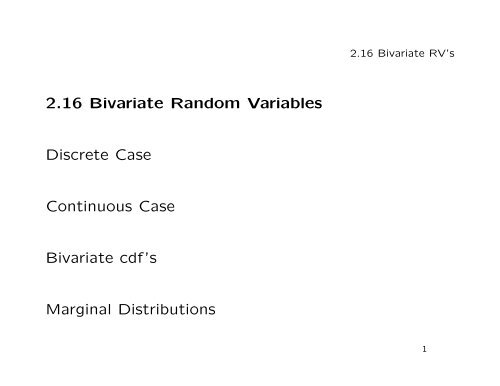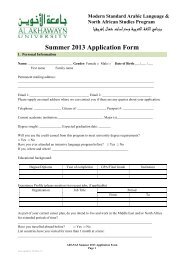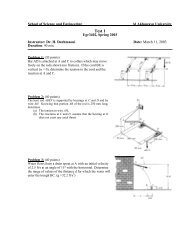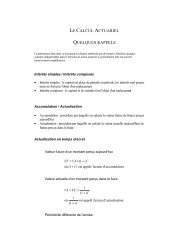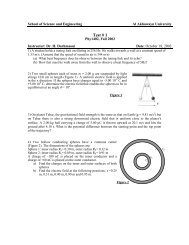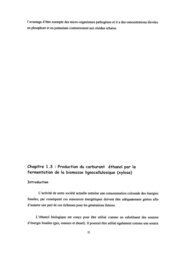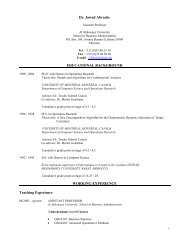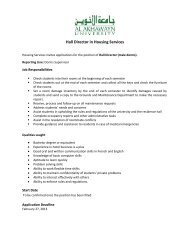2.16 Bivariate Random Variables Discrete Case Continuous Case ...
2.16 Bivariate Random Variables Discrete Case Continuous Case ...
2.16 Bivariate Random Variables Discrete Case Continuous Case ...
Create successful ePaper yourself
Turn your PDF publications into a flip-book with our unique Google optimized e-Paper software.
<strong>2.16</strong> <strong>Bivariate</strong> RV’s<br />
<strong>2.16</strong> <strong>Bivariate</strong> <strong>Random</strong> <strong>Variables</strong><br />
<strong>Discrete</strong> <strong>Case</strong><br />
<strong>Continuous</strong> <strong>Case</strong><br />
<strong>Bivariate</strong> cdf’s<br />
Marginal Distributions<br />
1
<strong>2.16</strong> <strong>Bivariate</strong> RV’s<br />
Now let’s look at what happens when you consider 2<br />
RV’s simultaneously.<br />
Example: Choose a person at random. Look at height<br />
and weight (X, Y ). Obviously, X and Y will be related<br />
somehow.<br />
2
<strong>2.16</strong> <strong>Bivariate</strong> RV’s<br />
<strong>Discrete</strong> <strong>Case</strong><br />
Definition: If X and Y are discrete RV’s, then (X, Y )<br />
is called a jointly discrete bivariate RV.<br />
The joint (or bivariate) pmf is<br />
f(x, y) = Pr(X = x, Y = y).<br />
Properties:<br />
(1) 0 ≤ f(x, y) ≤ 1.<br />
(2) ∑ x ∑ y f(x, y) =1.<br />
(3) A ⊆R 2 ⇒ Pr((X, Y ) ∈ A) = ∑∑ (x,y)∈A f(x, y). 3
<strong>2.16</strong> <strong>Bivariate</strong> RV’s<br />
Example: 3 sox in a box (numbered 1,2,3). Draw 2<br />
sox at random w/o replacement. X = # of first sock,<br />
Y = # of second sock. The joint pmf f(x, y) is<br />
X =1 X =2 X =3 Pr(Y = y)<br />
Y =1 0 1/6 1/6 1/3<br />
Y =2 1/6 0 1/6 1/3<br />
Y =3 1/6 1/6 0 1/3<br />
Pr(X = x) 1/3 1/3 1/3 1<br />
Pr(X = x) is the “marginal” distribution of X.<br />
Pr(Y = y) is the “marginal” distribution of Y .<br />
4
<strong>2.16</strong> <strong>Bivariate</strong> RV’s<br />
By the law of total probability,<br />
Pr(X =1) =<br />
In addition,<br />
3 ∑<br />
y=1<br />
Pr(X =1,Y = y) = 1/3.<br />
Pr(X ≥ 2,Y ≥ 2)<br />
= ∑ ∑<br />
x≥2 y≥2<br />
f(x, y)<br />
= f(2, 2) + f(2, 3) + f(3, 2) + f(3, 3)<br />
= 0+1/6+1/6+0 = 1/3.<br />
5
<strong>2.16</strong> <strong>Bivariate</strong> RV’s<br />
<strong>Continuous</strong> <strong>Case</strong><br />
Definition: If X and Y are cts RV’s, then (X, Y )isa<br />
jointly cts RV if there exists a function f(x, y) such<br />
that<br />
(1) f(x, y) ≥ 0, ∀x, y.<br />
(2) ∫∫ R 2 f(x, y) dx dy =1.<br />
(3) Pr(A) =Pr((X, Y ) ∈ A) = ∫∫ A f(x, y) dx dy.<br />
In this case, f(x, y) is called the joint pdf.<br />
6
<strong>2.16</strong> <strong>Bivariate</strong> RV’s<br />
If A ⊆R 2 ,thenPr(A) is the volume between f(x, y)<br />
and A.<br />
Think of<br />
f(x, y) dx dy ≈ Pr(x
<strong>2.16</strong> <strong>Bivariate</strong> RV’s<br />
Easy Example: Choose a point at random in the interior<br />
of the circle x 2 + y 2 = 16. Find the pdf of<br />
(X, Y ).<br />
Since the area of the circle is 16π,<br />
f(x, y) =<br />
⎧<br />
⎨<br />
⎩<br />
1<br />
16π if x2 + y 2 ≤ 16<br />
0 otherwise<br />
8
<strong>2.16</strong> <strong>Bivariate</strong> RV’s<br />
Example: Suppose that<br />
f(x, y) =<br />
⎧<br />
⎨<br />
⎩<br />
4xy if 0 ≤ x ≤ 1, 0 ≤ y ≤ 1<br />
0 otherwise<br />
Find the prob (volume) of the region 0 ≤ y ≤ 1 − x 2 .<br />
V =<br />
=<br />
∫ 1<br />
0<br />
∫ 1<br />
0<br />
= 1/3.<br />
∫ 1−x<br />
2<br />
0<br />
∫ √ 1−y<br />
Moral: Be careful with limits!<br />
0<br />
4xy dy dx<br />
4xy dx dy<br />
9
<strong>2.16</strong> <strong>Bivariate</strong> RV’s<br />
<strong>Bivariate</strong> cdf’s<br />
Definition: The joint (bivariate) cdf of X and Y is<br />
F (x, y) ≡ P (X ≤ x, Y ≤ y), for all x, y.<br />
F (x, y) =<br />
⎧<br />
⎪⎨<br />
⎪⎩<br />
∑∑<br />
s≤x,t≤y f(s, t)<br />
discrete<br />
∫ y<br />
−∞ ∫ x −∞ f(s, t) ds dt continuous<br />
10
<strong>2.16</strong> <strong>Bivariate</strong> RV’s<br />
Properties:<br />
F (x, y) is non-decreasing in both x and y.<br />
lim x→−∞ F (x, y) = lim y→−∞ F (x, y) =0.<br />
lim x→∞ F (x, y) =F Y (y) =Pr(Y ≤ y)<br />
lim y→∞ F (x, y) =F X (x) =Pr(X ≤ x).<br />
F (x, y) is cts from the right in both x and y.<br />
11
<strong>2.16</strong> <strong>Bivariate</strong> RV’s<br />
Going from cdf’s to pdf’s (continuous case).<br />
1-dimension: f(x) =F ′ (x) = d<br />
dx<br />
∫ x −∞ f(t) dt.<br />
2-D: f(x, y) =<br />
∂x∂y ∂2 F (x, y) =<br />
∂2<br />
∂x∂y<br />
∫ x −∞<br />
∫ y<br />
−∞ f(s, t) dt ds.<br />
12
<strong>2.16</strong> <strong>Bivariate</strong> RV’s<br />
Example: Suppose<br />
F (x, y) =<br />
⎧<br />
⎨<br />
⎩<br />
1 − e −x − e −y + e −(x+y) if x ≥ 0, y ≥ 0<br />
0 if x
<strong>2.16</strong> <strong>Bivariate</strong> RV’s<br />
The joint pdf is<br />
∂2<br />
f(x, y) = F (x, y)<br />
∂x∂y<br />
= ∂<br />
∂y (e−x − e −y e −x )<br />
=<br />
⎧<br />
⎨<br />
⎩<br />
e −(x+y) if x ≥ 0, y ≥ 0<br />
0 if x
<strong>2.16</strong> <strong>Bivariate</strong> RV’s<br />
Marginal Distributions — Distrns of X and Y .<br />
Example (discrete case): f(x, y) =Pr(X = x, Y = y).<br />
X =1 X =2 X =3 X =4 Pr(Y = y)<br />
Y =1 .01 .07 .09 .03 .2<br />
Y =2 .20 .00 .05 .25 .5<br />
Y =3 .09 .03 .06 .12 .3<br />
Pr(X = x) .3 .1 .2 .4 1<br />
By total probability,<br />
Pr(X =1)=Pr(X =1,Y = any #) = 0.3.<br />
15
<strong>2.16</strong> <strong>Bivariate</strong> RV’s<br />
Definition: If X and Y are jointly discrete, then the<br />
marginal pmf’s of X and Y are, respectively,<br />
f X (x) = ∑ y<br />
f(x, y)<br />
and<br />
f Y (y) = ∑ x f(x, y) 16
<strong>2.16</strong> <strong>Bivariate</strong> RV’s<br />
Example (discrete case): f(x, y) =Pr(X = x, Y = y).<br />
X =1 X =2 X =3 X =4 Pr(Y = y)<br />
Y =1 .06 .02 .04 .08 .2<br />
Y =2 .15 .05 .10 .20 .5<br />
Y =3 .09 .03 .06 .12 .3<br />
Pr(X = x) .3 .1 .2 .4 1<br />
Hmmm....<br />
Compared to the last example, this has<br />
the same marginals but different joint distribution!<br />
17
<strong>2.16</strong> <strong>Bivariate</strong> RV’s<br />
Definition: If X and Y are jointly cts, then the marginal<br />
pdf’s of X and Y are, respectively,<br />
f X (x) =<br />
∫<br />
R<br />
f(x, y) dy<br />
and<br />
f Y (y) =<br />
∫<br />
R f(x, y) dx 18
<strong>2.16</strong> <strong>Bivariate</strong> RV’s<br />
Example:<br />
f(x, y) =<br />
⎧<br />
⎨<br />
⎩<br />
e −(x+y) if x ≥ 0, y ≥ 0<br />
0 otherwise<br />
f X (x) =<br />
∫<br />
R<br />
f(x, y) dy<br />
=<br />
=<br />
∫ ∞<br />
0 e−(x+y) dy<br />
⎧<br />
⎨<br />
⎩<br />
e −x if x ≥ 0<br />
0 otherwise<br />
19
<strong>2.16</strong> <strong>Bivariate</strong> RV’s<br />
Example:<br />
f(x, y) =<br />
⎧<br />
⎨<br />
⎩<br />
21<br />
4<br />
x 2 y if x 2 ≤ y ≤ 1<br />
0 otherwise<br />
Note funny limits where the pdf is positive, i.e., x 2 ≤<br />
y ≤ 1.<br />
20
<strong>2.16</strong> <strong>Bivariate</strong> RV’s<br />
f X (x) =<br />
∫<br />
R<br />
f(x, y) dy<br />
=<br />
=<br />
∫ 1<br />
x 2 21<br />
4 x2 ydy<br />
⎧<br />
⎨<br />
⎩<br />
21<br />
8<br />
x 2 (1 − x 4 ) if −1 ≤ x ≤ 1<br />
0 otherwise<br />
21
<strong>2.16</strong> <strong>Bivariate</strong> RV’s<br />
f Y (y) =<br />
∫<br />
R<br />
f(x, y) dx<br />
=<br />
∫ √ y<br />
− √ y<br />
21<br />
4 x2 ydx<br />
=<br />
⎧<br />
⎨<br />
⎩<br />
7<br />
2 y5/2 if 0 ≤ y ≤ 1<br />
0 otherwise<br />
22


